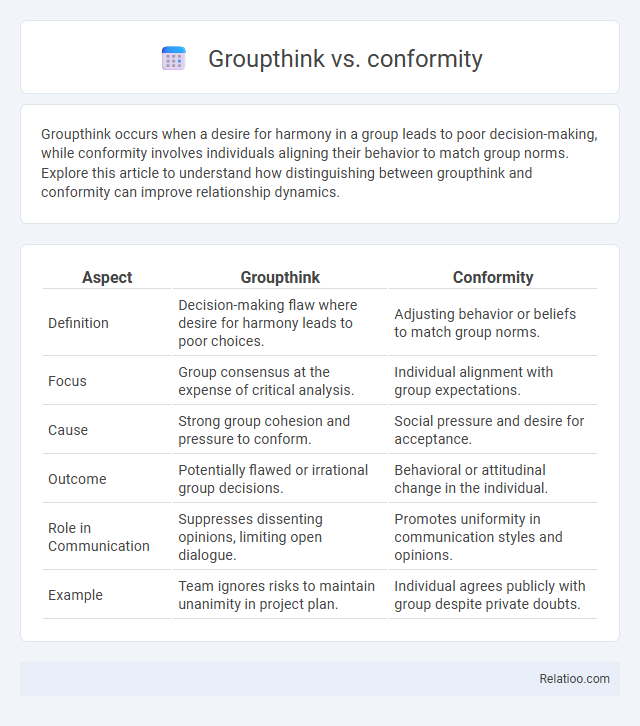Groupthink occurs when a desire for harmony in a group leads to poor decision-making, while conformity involves individuals aligning their behavior to match group norms. Explore this article to understand how distinguishing between groupthink and conformity can improve relationship dynamics.
Table of Comparison
| Aspect | Groupthink | Conformity |
|---|---|---|
| Definition | Decision-making flaw where desire for harmony leads to poor choices. | Adjusting behavior or beliefs to match group norms. |
| Focus | Group consensus at the expense of critical analysis. | Individual alignment with group expectations. |
| Cause | Strong group cohesion and pressure to conform. | Social pressure and desire for acceptance. |
| Outcome | Potentially flawed or irrational group decisions. | Behavioral or attitudinal change in the individual. |
| Role in Communication | Suppresses dissenting opinions, limiting open dialogue. | Promotes uniformity in communication styles and opinions. |
| Example | Team ignores risks to maintain unanimity in project plan. | Individual agrees publicly with group despite private doubts. |
Understanding Groupthink: Definition and Key Features
Groupthink is a psychological phenomenon where the desire for harmony in a decision-making group leads to irrational or dysfunctional outcomes, characterized by suppressing dissent and prioritizing consensus. Unlike conformity, which involves individuals adjusting their behavior to fit in with group norms, groupthink specifically results in flawed collective decisions due to pressures against opposing views. Your awareness of key features like illusion of invulnerability, collective rationalization, and self-censorship helps in identifying and mitigating groupthink in team environments.
What is Conformity? Types and Examples
Conformity involves adjusting your behaviors or beliefs to align with group norms, driven by social pressure or the desire for acceptance. Types of conformity include compliance, where you outwardly agree but privately disagree; identification, where you adopt behaviors to establish or maintain relationships; and internalization, where you genuinely accept the group's beliefs as your own. Examples of conformity range from changing your clothing style to match peers to agreeing with a team decision despite personal doubts.
Origins and Causes: Groupthink vs Conformity
Groupthink originates from high group cohesiveness combined with structural faults and situational pressures, leading members to prioritize harmony over critical evaluation. Conformity stems from social influence and normative pressures where individuals align their attitudes or behaviors to match group norms. While groupthink emphasizes collective decision-making flaws due to consensus-seeking, conformity focuses on individual behavioral change driven by the desire for social acceptance.
Psychological Mechanisms Behind Groupthink
Groupthink occurs when the desire for harmony in a decision-making group overrides realistic appraisal of alternatives, driven by psychological mechanisms such as self-censorship, illusion of unanimity, and pressure to conform. Conformity involves yielding to group norms and influences due to social pressure, but groupthink specifically entails collective cognitive biases that suppress dissent and critical thinking. Understanding these psychological mechanisms can help you recognize and mitigate groupthink in collaborative environments.
Forms and Influences of Conformity in Groups
Conformity in groups manifests primarily through compliance, identification, and internalization, each representing varying depths of influence on individual behavior. Social norms, peer pressure, and the desire for acceptance significantly drive conformity, shaping how your decisions align with group expectations. Understanding these forms and influences helps you navigate group dynamics effectively, avoiding pitfalls like groupthink where consensus overrides critical thinking.
Effects of Groupthink on Decision-Making
Groupthink significantly impairs decision-making by fostering an environment where dissenting opinions are suppressed, leading to poor evaluation of alternatives and increased risk of flawed outcomes. Your ability to critically analyze options diminishes as the desire for consensus overrides individual judgment, causing irrational or irrationally risky decisions. This phenomenon contrasts with conformity, which primarily influences individual behavior to align with group norms without necessarily impairing the decision quality.
Social Pressures: How Conformity Shapes Behavior
Social pressures significantly influence conformity by compelling individuals to align their behaviors and opinions with group norms to gain acceptance and avoid rejection. Groupthink intensifies this dynamic, as the desire for unanimity suppresses dissent and critical thinking, leading to poor decision-making outcomes. Unlike conformity, which involves adapting to social expectations broadly, groupthink specifically arises in cohesive groups prioritizing consensus over individual judgment.
Groupthink vs Conformity: Key Differences
Groupthink occurs when a cohesive group prioritizes unanimity and suppresses dissenting opinions, leading to poor decision-making, while conformity involves individuals aligning their behaviors or beliefs to fit social norms or expectations. Unlike conformity, which can be voluntary and driven by social pressures, groupthink emerges from a collective desire to avoid conflict and achieve consensus within the group. Key differences include the scope of influence--groupthink affects group-level decisions, whereas conformity pertains to individual alignment with group norms.
Real-World Examples: Groupthink and Conformity in Action
Groupthink often leads to poor decision-making in organizations, exemplified by the 1986 Challenger disaster where NASA's team ignored critical warnings to maintain consensus. Conformity is evident in social experiments like Asch's line test, where individuals align with majority opinions despite conflicting personal judgments. Understanding these dynamics helps you recognize how pressures to conform or prioritize harmony over critical analysis impact real-world groups and decision outcomes.
Preventing Groupthink and Harmful Conformity
Preventing groupthink requires fostering an open environment where diverse viewpoints are encouraged and critical thinking is prioritized to avoid poor decision-making influenced by unanimous pressure. Harmful conformity can be minimized by empowering individuals to express unique perspectives and challenging group norms that suppress innovation or ethical standards. Your leadership in promoting psychological safety and independent reasoning is essential to safeguard against these detrimental group dynamics.

Infographic: Groupthink vs Conformity
 relatioo.com
relatioo.com